Nanotechnology Market Size
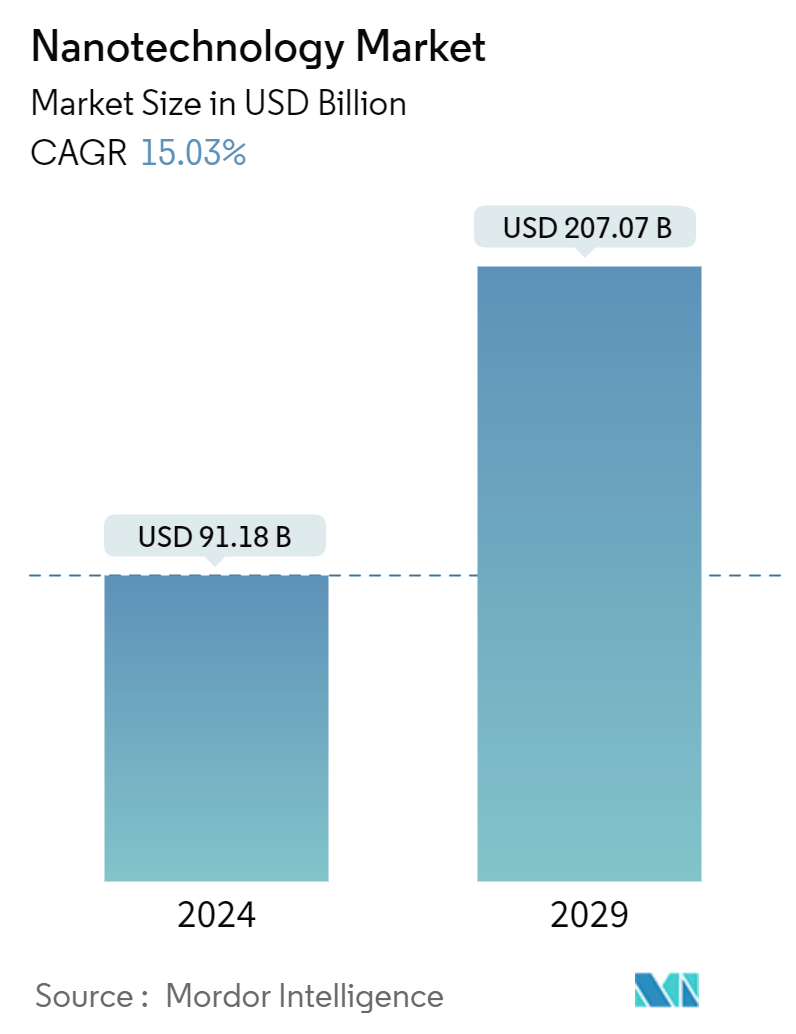
| Study Period | 2019 - 2029 |
| Market Size (2024) | USD 91.18 Billion |
| Market Size (2029) | USD 207.07 Billion |
| CAGR (2024 - 2029) | 15.03 % |
| Fastest Growing Market | Asia Pacific |
| Largest Market | North America |
Major Players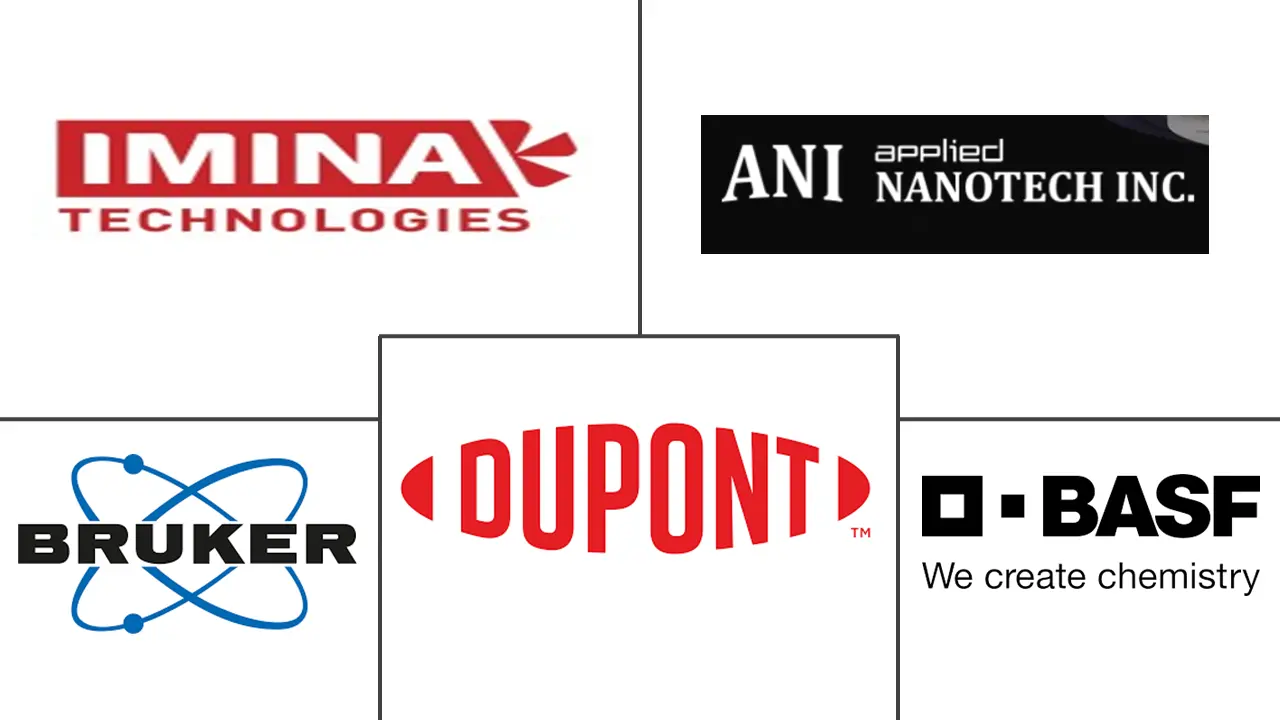
*Disclaimer: Major Players sorted in no particular order |
Nanotechnology Market Analysis
The Nanotechnology Market size is estimated at USD 91.18 billion in 2024, and is expected to reach USD 207.07 billion by 2029, growing at a CAGR of 15.03% during the forecast period (2024-2029).
- Nanotechnology constructs intricate structures at the molecular or atomic level, enabling the production of superior-quality goods at lower costs. This advanced technology finds applications across various industrial sectors. The rising integration of nanotechnology in the medical field, coupled with a trend toward miniaturization in sectors like electronics, textiles, and aerospace, is poised to propel the market's growth in the coming years.
- Nanomaterials, encompassing nanoparticles, nanofibers, and nanotubes, possess distinct properties that can significantly enhance the delivery and efficacy of pharmaceutical drugs. These materials improve drug solubility, stability, and targeted delivery, increasing bioavailability and therapeutic outcomes. By encapsulating and safeguarding sensitive drugs within nanocarriers, nanomaterials address numerous challenges associated with conventional drug delivery methods.
- Engineered nanomaterials can precisely target specific cells, tissues, or organs, amplifying the drug's effectiveness while minimizing side effects. Additionally, nanoparticles can be programmed for controlled drug release, ensuring therapeutic agents are delivered precisely where and when needed. This approach is particularly advantageous for treating cancer, cardiovascular disorders, and neurological conditions.
- Further, recent advancements in nanofabrication techniques, including lithography, self-assembly, and bottom-up methods, have enhanced the ability to construct and manipulate nanoscale structures precisely. Improved characterization tools, such as scanning probe microscopy, electron microscopy, and various spectroscopic techniques, have deepened the understanding and analysis of nanomaterials and their properties. These technological advancements in nanofabrication and characterization have accelerated the development and optimization of nano-enabled products and applications.
- Extensive research and development efforts are essential for creating new nanomaterials, nanodevices, and nano-enabled applications. However, the journey is fraught with challenges: the specialized equipment, advanced instrumentation, and the expertise of highly skilled personnel come at a steep price. Coupled with the intricate and iterative nature of nanotechnology research, which demands rigorous testing and validation, these factors lead to substantial R&D expenditures.
- The realm of nanotechnology, be it in research, development, or production, mandates a specialized infrastructure. This includes advanced characterization tools, sophisticated imaging systems, and meticulously controlled environments. The costs escalate with the maintenance and necessary upgrades of these specialized instruments and facilities. Moreover, the expertise of highly skilled personnel, essential for operating and maintaining these advanced systems, further amplifies the financial commitment.
Nanotechnology Market Trends
Medical and Healthcare Application is Expected to Hold Significant Market Share
- Nanotechnology has driven significant advancements in nanomedicine, leading to the development of nanoparticles, nanodevices, and nanomaterials for various medical applications. These nano-based solutions are utilized for targeted drug delivery, early disease detection, tissue engineering, and personalized healthcare, among other applications. The unique properties of nanomaterials, such as high surface area, smaller size, and targeted functionality, make them suitable for medical and healthcare applications.
- Nanotechnology has enabled the development of advanced diagnostic tools and devices, such as nano biosensors, to provide early and more accurate detection of diseases and health conditions. These nano-based diagnostic tools offer improved sensitivity, specificity, and faster results than conventional diagnostic methods, leading to more timely and effective interventions. Integrating nanotechnology with imaging techniques, such as MRI and CT, has also enhanced the capabilities of medical diagnostics.
- Moreover, chronic diseases, including diabetes, heart disease, stroke, and cancer, are among the leading causes of global morbidity and mortality in the United States. According to the American Cancer Society, about 299,010 men in the United States are estimated to be diagnosed with prostate cancer in 2024. The growing instances of chronic diseases like cancer and an intensified focus on preventive healthcare propel the demand for cutting-edge, nanotechnology-driven medical and healthcare solutions. Significant investments are being funneled into the development and commercialization of nanotechnology applications in the medical and healthcare sectors by governments, research institutions, and private enterprises alike.
- Personalized and precision medicine heavily relies on this crucial enabler, tailoring treatments to meet individual patient needs and genetic profiles. Nano-based theranostics (integrating therapeutic and diagnostic functions) facilitate simultaneous diagnosis, monitoring, and personalized treatment of diverse diseases. Such an approach enhances patient outcomes, minimizes side effects, and optimizes healthcare resource utilization.
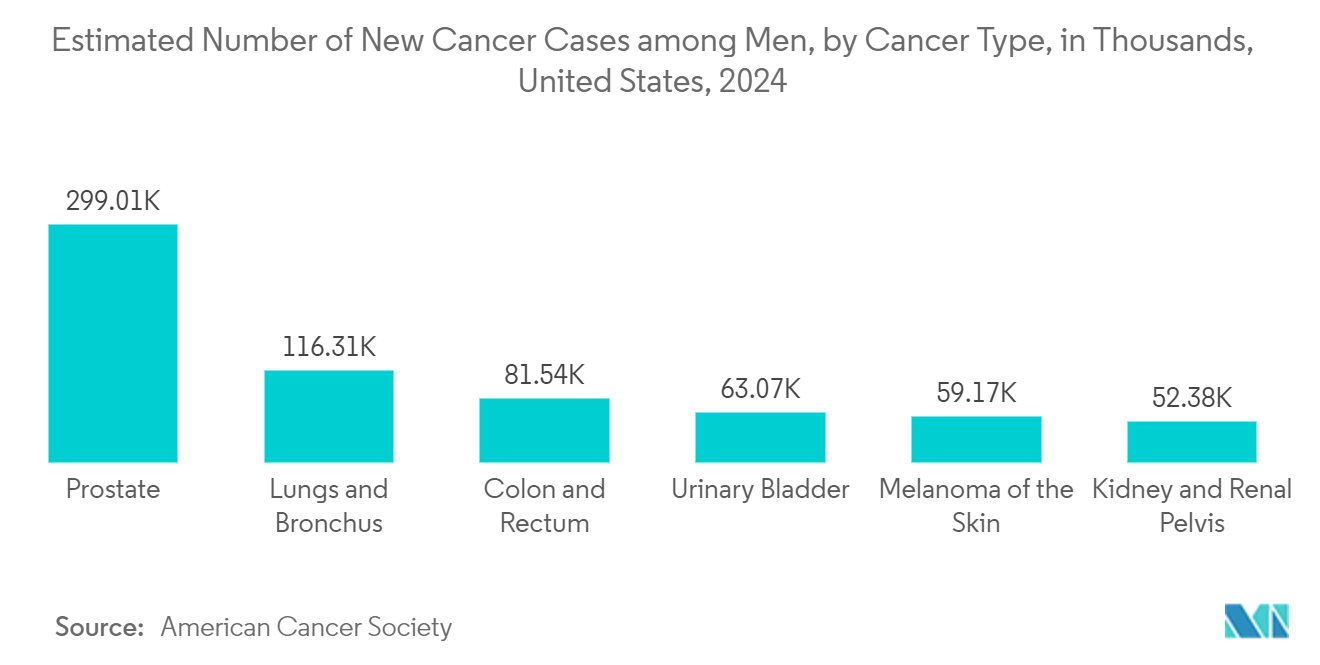
North America is Expected to Hold Significant Market Share
- North America boasts a robust nanotech industry, home to prominent companies, esteemed research institutions, and specialized service providers. Bolstered by strong manufacturing capabilities and infrastructure, the region adeptly produces and scales up nanotechnology-based products. Furthermore, North America's skilled workforce, cutting-edge manufacturing techniques, and well-established supply chain reinforce its leading stance in the nanotechnology market.
- The regional players are heavily investing in research and development within the nanotechnology sector. Major universities, government entities, and private firms are fueling innovation and technological progress through substantial investments in nanotechnology R&D. This momentum is bolstered by the region's robust funding, established infrastructure, and a deep talent pool, all of which facilitate the advancement and market introduction of nanotechnology applications.
- For instance, in the 2024 Budget, the President of the United States has proposed an allocation of USD 2.16 billion for the National Nanotechnology Initiative (NNI). This budget emphasizes continued investments in foundational research to spur new discoveries. Additionally, there's a heightened focus on application-driven R&D, targeting the advancement of future technologies and addressing pressing national priorities.
- Further, the region leads in the commercialization and adoption of products and applications rooted in nanotechnology. Major players in electronics, healthcare, and materials science are based in the region, and nanotechnology is swiftly integrated into their offerings. Additionally, supportive regulatory frameworks and policies further promote the development and implementation of nanotechnology solutions.
- Moreover, stringent government regulations aimed at mitigating health hazards associated with nanomaterials are poised to drive growth in the studied market. For instance, the EPA is adopting a comprehensive regulatory approach under TSCA to safeguard health and the environment from various risks associated with nanoscale materials. This includes implementing an information-gathering rule for new and existing nanomaterials and requiring premanufacture notifications for any new nanomaterials.
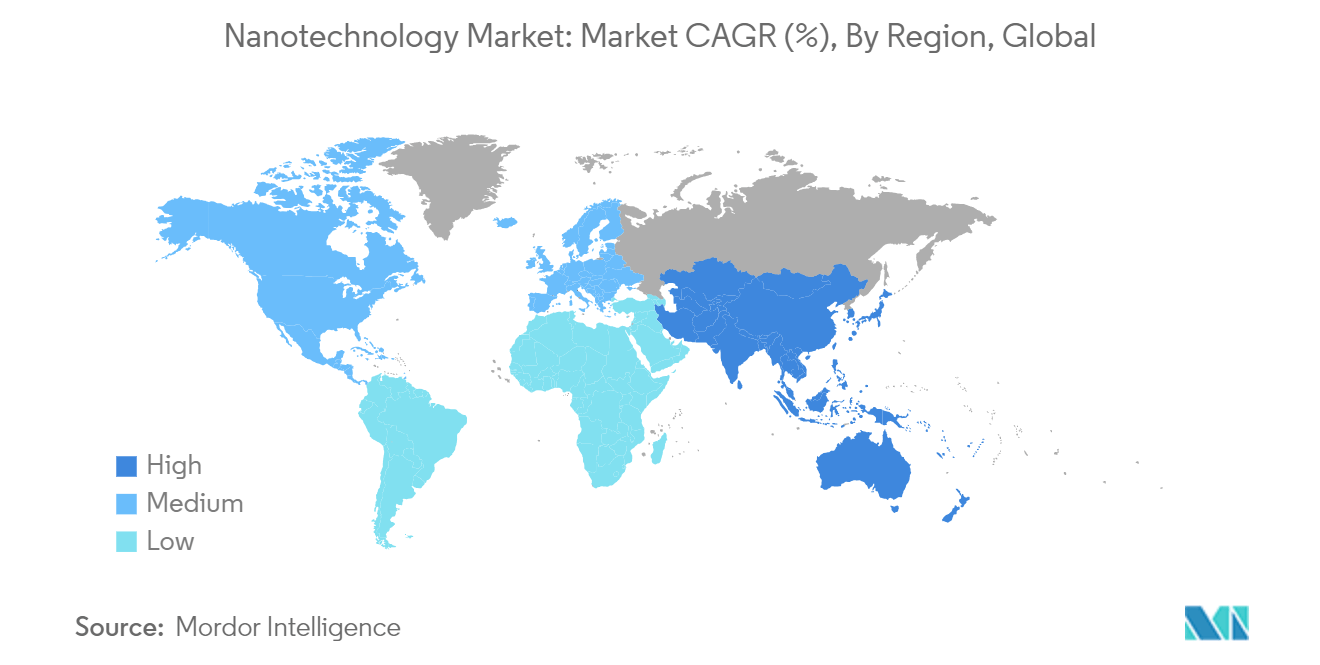
Nanotechnology Industry Overview
The Nanotechnology market is highly competitive, with several global and regional players. Companies emphasize increasing their market share through partnerships with several research institutions worldwide. In addition, they are investing in research and development to extend their portfolio. Some of the significant players are Imina Technologies SA, Applied Nanotech, Inc., Bruker, DuPont de Nemours, Inc., and BASF SE.
- August 2024: Researchers at the Institute of Chemical Research of Catalonia (ICIQ-CERCA) pioneered a computational methodology. This innovative approach simulates intricate processes involving diverse chemical species and conditions. The primary focus is on deciphering the formation of polyoxometalates (POMs) - nanostructures with crucial roles in catalysis, biology, energy storage, and medicine.
- August 2024: Researchers at the University of Chemistry and Technology in Prague successfully synthesized bimetallic nanoparticles using waste extracts from Cannabis sativa and Vitis vinifera. This eco-friendly approach highlights plant waste's valorization and showcases the nanoparticles' potent antimicrobial properties. The study underscores its commitment to a circular economy by turning agricultural waste into valuable materials.
Nanotechnology Market Leaders
-
Imina Technologies SA
-
Applied Nanotech, Inc.
-
Bruker
-
DuPont de Nemours, Inc.
-
BASF SE
*Disclaimer: Major Players sorted in no particular order
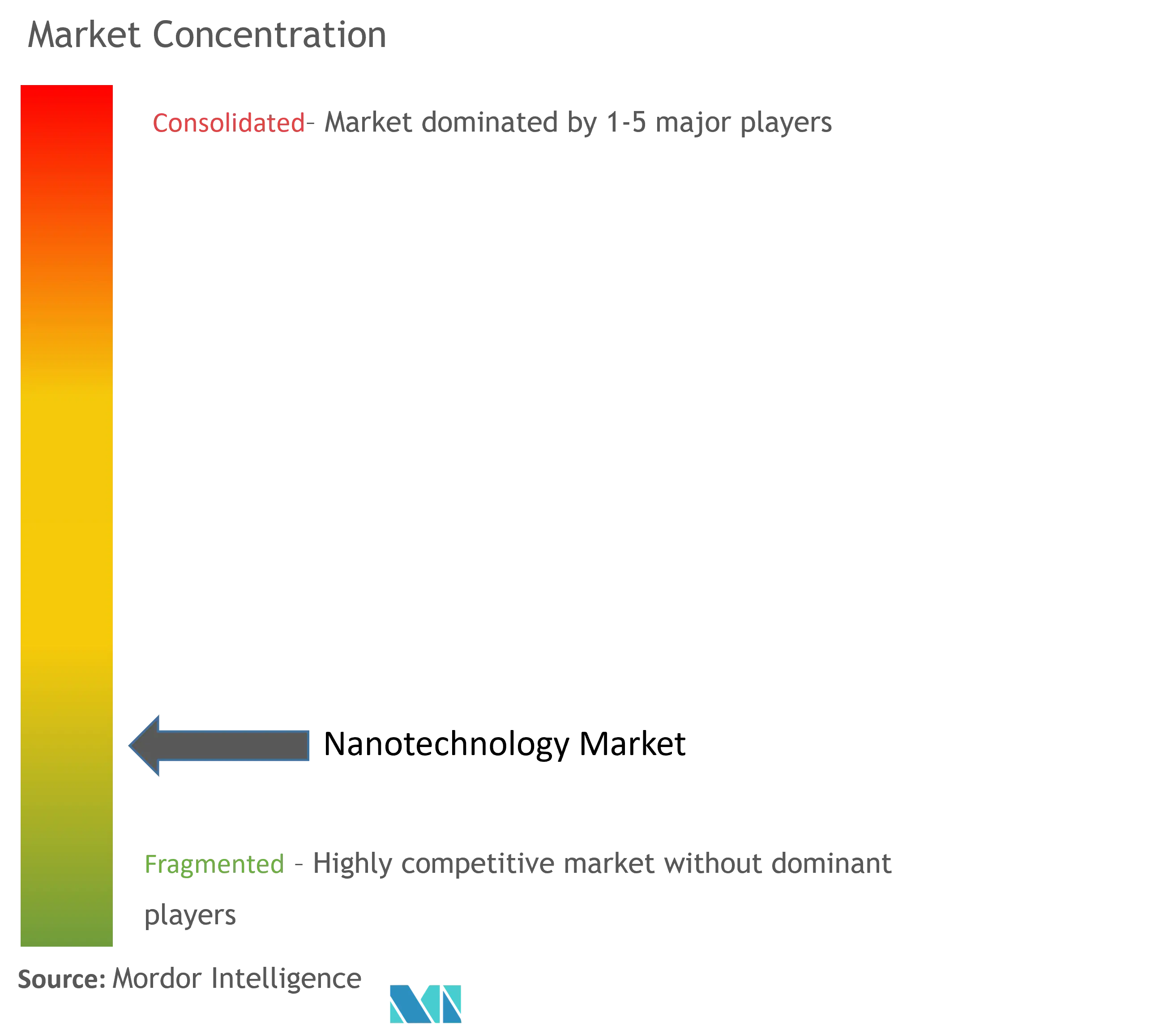
Nanotechnology Market News
- June 2024: OCSiAl finalized the construction of a facility in Serbia dedicated to producing single-wall carbon nanotube (SWCNT) dispersions. This initiative plans to bolster the production of high-performance batteries. The facility's output has already been secured by prominent global electric vehicle (EV) manufacturers, and OCSiAl is collaborating with the world's largest lithium-ion (Li-ion) battery cell producers.
- February 2024: Bruker and the University of Sydney signed a precision-medicine research partnership. This collaboration positions the University of Sydney as a global frontrunner in advancing nanomedicine, gene therapies, and proactive disease detection, treatment, and prevention measures. In a notable advancement for precision medicine, researchers at the University of Sydney have unveiled a five-year research partnership with Bruker. As part of this collaboration, the University will enhance its top-tier research facilities by integrating two Bruker atomic force microscopes.
Nanotechnology Market Report - Table of Contents
1. INTRODUCTION
- 1.1 Study Assumptions and Market Definition
- 1.2 Scope of the Study
2. RESEARCH METHODOLOGY
3. EXECUTIVE SUMMARY
4. MARKET INSIGHTS
- 4.1 Market Overview
-
4.2 Industry Attractiveness - Porter's Five Forces Analysis
- 4.2.1 Threat of New Entrants
- 4.2.2 Bargaining Power of Buyers
- 4.2.3 Bargaining Power of Suppliers
- 4.2.4 Threat of Substitute Products
- 4.2.5 Intensity of Competitive Rivalry
- 4.3 Industry Value Chain Analysis
- 4.4 An Assessment of Macroeconomic Trends on the Market
5. MARKET DYNAMICS
-
5.1 Market Drivers
- 5.1.1 Rising Adoption of Nanomaterials in Drug Delivery and Medical Devices
- 5.1.2 Advancements in Nanotechnology
-
5.2 Market Restraints
- 5.2.1 Elevated Expenses Linked to the Research, Development, and Production of Nanotechnology
- 5.2.2 The Potential Health Hazards of Nanomaterials are Generating Uncertainty
6. MARKET SEGMENTATION
-
6.1 By Type
- 6.1.1 Nanomaterials
- 6.1.2 Nanocomposites
- 6.1.3 Nanodevices
- 6.1.4 Other Types
-
6.2 By Application
- 6.2.1 Medical and Healthcare
- 6.2.2 Material Science
- 6.2.3 Energy Storage and Production
- 6.2.4 Environmental
- 6.2.5 Electronics and Computing
- 6.2.6 Cosmetics and Personal Care Products
- 6.2.7 Food Science
- 6.2.8 Textile
-
6.3 By Geography***
- 6.3.1 North America
- 6.3.2 Europe
- 6.3.3 Asia
- 6.3.4 Australia and New Zealand
- 6.3.5 Latin America
- 6.3.6 Middle East and Africa
7. COMPETITIVE LANDSCAPE
-
7.1 Company Profiles*
- 7.1.1 Imina Technologies S.A.
- 7.1.2 Applied Nanotech Inc.
- 7.1.3 Bruker
- 7.1.4 DuPont de Nemours Inc.
- 7.1.5 ANP Corporation
- 7.1.6 eSpin Technologies Inc.
- 7.1.7 Thermo Fischer Scientific Inc.
- 7.1.8 Asahi Kasei Corporation
- 7.1.9 Kleindiek Nanotechnik GmbH
- 7.1.10 Integran Technologies
- 7.1.11 Nanonics Imaging Ltd
- 7.1.12 BASF SE
8. INVESTMENT ANALYSIS
9. FUTURE OF THE MARKET
** Subject To AvailablityNanotechnology Industry Segmentation
Nanotechnology encompasses the science and engineering disciplines focused on designing, producing, and utilizing structures, devices, and systems by manipulating atoms and molecules at the nanoscale—specifically, at 100 nanometers (100 millionths of a millimeter) or smaller dimensions. Nanotechnology has found its way into several domains, with industrial sectors leading the charge, especially information and communications.
The study comprehensively analyzes the trends and dynamics of nanotechnology adoption across different verticals. It also monitors the revenue generated from various types of nanotechnology utilized in several applications.
The nanotechnology market is segmented by type (nanomaterials, nanocomposites, nanodevices, and other types), application (medical and healthcare, material science, energy storage and production, environmental, electronics and computing, cosmetics and personal care products, food science, and textile), and geography (North America, Europe, Asia, Australia and New Zealand, Latin America, and Middle East and Africa). The report offers market forecasts and size in value (USD) for all the above segments.
| By Type | Nanomaterials |
| Nanocomposites | |
| Nanodevices | |
| Other Types | |
| By Application | Medical and Healthcare |
| Material Science | |
| Energy Storage and Production | |
| Environmental | |
| Electronics and Computing | |
| Cosmetics and Personal Care Products | |
| Food Science | |
| Textile | |
| By Geography*** | North America |
| Europe | |
| Asia | |
| Australia and New Zealand | |
| Latin America | |
| Middle East and Africa |
Nanotechnology Market Research FAQs
How big is the Nanotechnology Market?
The Nanotechnology Market size is expected to reach USD 91.18 billion in 2024 and grow at a CAGR of 15.03% to reach USD 207.07 billion by 2029.
What is the current Nanotechnology Market size?
In 2024, the Nanotechnology Market size is expected to reach USD 91.18 billion.
Who are the key players in Nanotechnology Market?
Imina Technologies SA, Applied Nanotech, Inc., Bruker, DuPont de Nemours, Inc. and BASF SE are the major companies operating in the Nanotechnology Market.
Which is the fastest growing region in Nanotechnology Market?
Asia Pacific is estimated to grow at the highest CAGR over the forecast period (2024-2029).
Which region has the biggest share in Nanotechnology Market?
In 2024, the North America accounts for the largest market share in Nanotechnology Market.
What years does this Nanotechnology Market cover, and what was the market size in 2023?
In 2023, the Nanotechnology Market size was estimated at USD 77.48 billion. The report covers the Nanotechnology Market historical market size for years: 2019, 2020, 2021, 2022 and 2023. The report also forecasts the Nanotechnology Market size for years: 2024, 2025, 2026, 2027, 2028 and 2029.
Nanotechnology Industry Report
Statistics for the 2024 Nanotechnology market share, size and revenue growth rate, created by Mordor Intelligence™ Industry Reports. Nanotechnology analysis includes a market forecast outlook for 2024 to 2029 and historical overview. Get a sample of this industry analysis as a free report PDF download.



